NCERT Solutions | Class 12 Maths Chapter 9 | Differential Equations

CBSE Solutions | Maths Class 12
Check the below NCERT Solutions for Class 12 Maths Chapter 9 Differential Equations Pdf free download. NCERT Solutions Class 12 Maths were prepared based on the latest exam pattern. We have Provided Differential Equations Class 12 Maths NCERT Solutions to help students understand the concept very well.
NCERT | Class 12 Maths
| Book: | National Council of Educational Research and Training (NCERT) |
|---|---|
| Board: | Central Board of Secondary Education (CBSE) |
| Class: | 12th |
| Subject: | Maths |
| Chapter: | 9 |
| Chapters Name: | Differential Equations |
| Medium: | English |
Differential Equations | Class 12 Maths | NCERT Books Solutions
NCERT Solutions for Class 12 Maths Chapter 9 Differential Equations Ex 9.1
Determine order and degree (if defined) of the differential equations given in Questions 1 to 10.
Looking for a tool that does Partial Derivation easily? Utilize our Partial Derivative Calculator tool and obtain the result instantly.
Ex 9.1 Class 12 Maths Question 1.
\(\frac { { d }^{ 4 }y }{ { dx }^{ 4 } } +({ sin }y^{ III })=0\)
Solution.
Order of the equation is 4
It is not a polynomial in derivatives so that it
has not degree.
Ex 9.1 Class 12 Maths Question 2.
\({ y }^{ I }+5y=0\)
Solution.
\({ y }^{ I }+5y=0\)
It is a D.E. of order one and degree one.
Ex 9.1 Class 12 Maths Question 3.
\({ \left( \frac { ds }{ dt } \right) }^{ 4 }+3s{ \left( \frac { { d }^{ 2 }s }{ { dt }^{ 2 } } \right) }=0\)
Solution.
Order of the equation is 2.
Degree of the equation is
Ex 9.1 Class 12 Maths Question 4.
\({ \left( \frac { { d }^{ 2 }y }{ { dx }^{ 2 } } \right) }^{ 2 }+cos\left( \frac { dy }{ dx } \right) =0\)
Solution.
\({ \left( \frac { { d }^{ 2 }y }{ { dx }^{ 2 } } \right) }^{ 2 }+cos\left( \frac { dy }{ dx } \right) =0\)
It is a D.E. of order 2 and degree undefined
Ex 9.1 Class 12 Maths Question 5.
\(\frac { { d }^{ 2 }y }{ { dx }^{ 2 } } =cos3x+sin3x\)
Solution.
\(\frac { { d }^{ 2 }y }{ { dx }^{ 2 } } =cos3x+sin3x\)
It is a D.E. of order 2 and degree 1.
Ex 9.1 Class 12 Maths Question 6.
\({ { (y }^{ III }) }^{ 2 }+{ { ( }y^{ II }) }^{ 3 }+{ { (y }^{ I }) }^{ 4 }+{ y }^{ 5 }=0\)
Solution.
Order of the equation is 3
Degree of the equation is 2
Ex 9.1 Class 12 Maths Question 7.
\({ { y }^{ III } }+{ 2y^{ II } }+{ { y }^{ I } }=0\)
Solution.
\({ { y }^{ III } }+{ 2y^{ II } }+{ { y }^{ I } }=0\)
The highest order derivative is y.
Thus the order of the D.E. is 3.
The degree of D.E is 1
Ex 9.1 Class 12 Maths Question 8.
\({ y }^{ I }+y={ e }^{ x }\)
Solution.
\({ y }^{ I }+y={ e }^{ x }\)
The order of the D. E. = 1 (highest order derivative)
The degree of the D.E. = 1.
Ex 9.1 Class 12 Maths Question 9.
\({ y }^{ III }+{ { (y }^{ I }) }^{ 2 }+2y=0\)
Solution.
\({ y }^{ III }+{ { (y }^{ I }) }^{ 2 }+2y=0\)
The highest derivative is 2.
Order of the D.E. = 2.
Degree of the D. E = 1
Ex 9.1 Class 12 Maths Question 10.
\({ y }^{ II }+{ { 2y }^{ I } }+siny=0\)
Solution.
Order of the equation is 2
Degree of the equation is 1
Ex 9.1 Class 12 Maths Question 11.
The degree of the differential equation
\({ \left( \frac { { d }^{ 2 }y }{ { dx }^{ 2 } } \right) }^{ 3 }{ +\left( \frac { dy }{ dx } \right) }^{ 2 }+sin{ \left( \frac { dy }{ dx } \right) }+1=0\)
(a) 3
(b) 2
(c) 1
(d) not defined
Solution.
\({ \left( \frac { { d }^{ 2 }y }{ { dx }^{ 2 } } \right) }^{ 3 }{ +\left( \frac { dy }{ dx } \right) }^{ 2 }+sin{ \left( \frac { dy }{ dx } \right) }+1=0\)
The degree not defined.
Because the differential equation can not be written as a polynomial in all the differential coefficients.
Hence option (d) is correct.
Ex 9.1 Class 12 Maths Question 12.
The order of the differential equation
\({ 2x }^{ 2 }\frac { { d }^{ 2 }y }{ { dx }^{ 2 } } -3\frac { dy }{ dx } +y=0\)
(a) 2
(b) 1
(c) 0
(d) not defined
Solution.
\({ 2x }^{ 2 }\frac { { d }^{ 2 }y }{ { dx }^{ 2 } } -3\frac { dy }{ dx } +y=0\)
Thus order of the D.E. = 2
Hence option (a) is correct.
NCERT Solutions for Class 12 Maths Chapter 9 Differential Equations Ex 9.2
Verify that the given functions (explicit or implicit) is a solution of the corresponding differential equation
<Ex 9.2 Class 12 Maths Question 1.
\(y={ e }^{ x }+1:{ y }^{ II }-{ y }^{ I }=0\)
Solution.
\(y={ e }^{ x }+1:{ y }^{ II }-{ y }^{ I }=0\)

Ex 9.2 Class 12 Maths Question 2.
\(y=x^{ 2 }+2x+c:{ y }^{ I }-2x-2=0\)
Solution.
\(y=x^{ 2 }+2x+c:{ y }^{ I }-2x-2=0\)
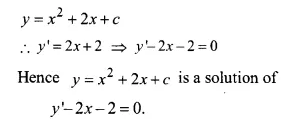
Ex 9.2 Class 12 Maths Question 3.
\(y=cosx+c:{ y }^{ I }+sinx=0\)
Solution.
\(y=cosx+c:{ y }^{ I }+sinx=0\)

Ex 9.2 Class 12 Maths Question 4.
\(y=\sqrt { 1+{ x }^{ 2 } } :{ y }^{ I }=\frac { xy }{ 1+{ x }^{ 2 } } \)
Solution.
\(y=\sqrt { 1+{ x }^{ 2 } } :{ y }^{ I }=\frac { xy }{ 1+{ x }^{ 2 } } \)
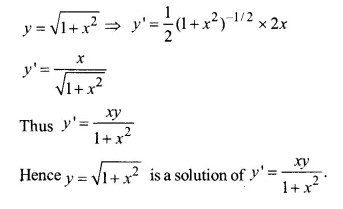
Ex 9.2 Class 12 Maths Question 5.
\(y=Ax:x{ y }^{ I }=y(x\neq 0)\)
Solution.
\(y=Ax:x{ y }^{ I }=y(x\neq 0)\)
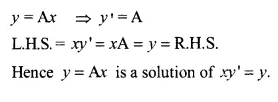
Ex 9.2 Class 12 Maths Question 6.
\(y=x\quad sinx;{ xy }^{ I }=y+x\sqrt { { x }^{ 2 }-{ y }^{ 2 } } (x\neq 0\quad and\quad x>y\quad or\quad x<-y)\)
Solution.
\(y=x\quad sinx;{ xy }^{ I }=y+x\sqrt { { x }^{ 2 }-{ y }^{ 2 } } (x\neq 0\quad and\quad x>y\quad or\quad x<-y)\)

Ex 9.2 Class 12 Maths Question 7.
xy = logy + C,

Solution.
xy = logy + C,
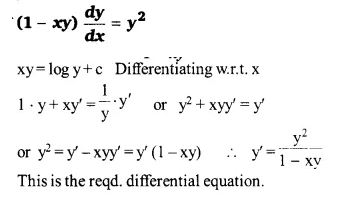
Ex 9.2 Class 12 Maths Question 8.
\(y-cosy=x:(ysiny+cosy+x){ y }^{ I }=y\)
Solution.
\(y-cosy=x:(ysiny+cosy+x){ y }^{ I }=y\)
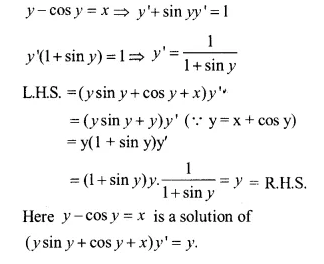
Ex 9.2 Class 12 Maths Question 9.
\(x+y={ ta }n^{ -1 }y;{ y }^{ 2 }{ y }^{ I }+{ y }^{ 2 }+1=0\)
Solution.
\(x+y={ ta }n^{ -1 }y;{ y }^{ 2 }{ y }^{ I }+{ y }^{ 2 }+1=0\)

Ex 9.2 Class 12 Maths Question 10.
\(y=\sqrt { { a }^{ 2 }-{ x }^{ 2 } } x\in (-a,a);x+y\frac { dy }{ dx } =0,(y\neq 0)\)
Solution.
\(y=\sqrt { { a }^{ 2 }-{ x }^{ 2 } } x\in (-a,a);x+y\frac { dy }{ dx } =0,(y\neq 0)\)
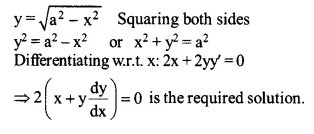
Ex 9.2 Class 12 Maths Question 11.
The number of arbitrary constants in the general solution of a differential equation of fourth order are:
(a) 0
(b) 2
(c) 3
(d) 4
Solution.
(b) The general solution of a differential equation of fourth order has 4 arbitrary constants.
Because it contains the same number of arbitrary constants as the order of differential equation.
Ex 9.2 Class 12 Maths Question 12.
The number of arbitrary constants in the particular solution of a differential equation of third order are:
(a) 3
(b) 2
(c) 1
(d) 0
Solution.
(d) Number of arbitrary constants = 0
Because particular solution is free from arbitrary constants.
NCERT Solutions for Class 12 Maths Chapter 9 Differential Equations Ex 9.3
In each of the following, Q. 1 to 5 form a differential equation representing the given family of curves by eliminating arbitrary constants a and b.
<Ex 9.3 Class 12 Maths Question 1.
\(\frac { x }{ a } +\frac { y }{ b } =1\)
Solution.
Given that \(\frac { x }{ a } +\frac { y }{ b } =1\) …(i)
differentiating (i) w.r.t x, we get
\(\frac { 1 }{ a } +\frac { 1 }{ b } { y }^{ I }=0\) …(ii)
again differentiating w.r.t x, we get
\(\frac { 1 }{ b } { y }^{ II }=0\Rightarrow { y }^{ II }=0\)
which is the required differential equation
Ex 9.3 Class 12 Maths Question 2.
y² = a(b² – x²)
Solution.
given that
y² = a(b² – x²)…(i)
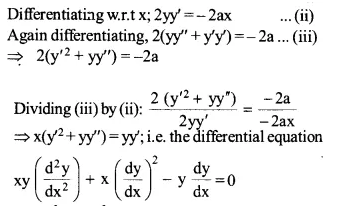
Ex 9.3 Class 12 Maths Question 3.
y = ae3x+be-2x
Solution.
Given that
y = ae3x+be-2x …(i)
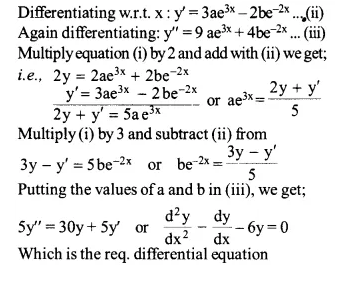
Ex 9.3 Class 12 Maths Question 4.
y = e2x (a+bx)
Solution.
y = e2x (a+bx)

Ex 9.3 Class 12 Maths Question 5.
y = ex(a cosx+b sinx)
Solution.
The curve y = ex(a cosx+b sinx) …(i)
differentiating w.r.t x

Ex 9.3 Class 12 Maths Question 6.
Form the differential equation of the family of circles touching the y axis at origin
Solution.
The equation of the circle with centre (a, 0) and radius a, which touches y- axis at origin
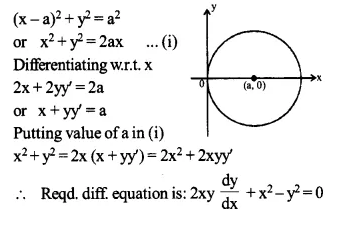
Ex 9.3 Class 12 Maths Question 7.
Form the differential equation of the family of parabolas having vertex at origin and axis along positive y-axis.
Solution.
The equation of parabola having vertex at the origin and axis along positive y-axis is

Ex 9.3 Class 12 Maths Question 8.
Form the differential equation of family of ellipses having foci on y-axis and centre at origin.
Solution.
The equation of family ellipses having foci at y- axis is
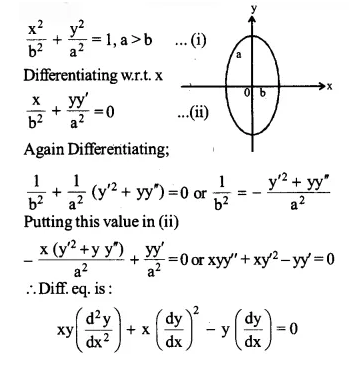
Ex 9.3 Class 12 Maths Question 9.
Form the differential equation of the family of hyperbolas having foci on x-axis and centre at the origin.
Solution.
Equation of the hyperbola is \(\frac { { x }^{ 2 } }{ { a }^{ 2 } } -\frac { { y }^{ 2 } }{ { b }^{ 2 } } =1\)
Differentiating both sides w.r.t x
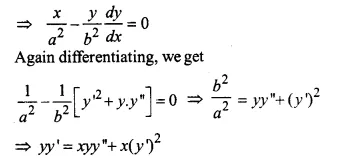
which is the req. differential eq. of the hyperbola.
Ex 9.3 Class 12 Maths Question 10.
Form the differential equation of the family of circles having centre on y-axis and radius 3 units
Solution.
Let centre be (0, a) and r = 3
Equation of circle is
x² + (y – a)² = 9 …(i)
Differentiating both sides, we get
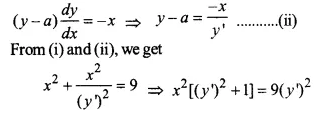
which is required equation
Ex 9.3 Class 12 Maths Question 11.
Which of the following differential equation has \(y={ c }_{ 1 }{ e }^{ x }+{ c }_{ 2 }{ e }^{ -x }\) as the general solution ?
(a) \(\frac { { d }^{ 2 }y }{ { dx }^{ 2 } } +y=0\)
(b) \(\frac { { d }^{ 2 }y }{ { dx }^{ 2 } } -y=0\)
(c) \(\frac { { d }^{ 2 }y }{ { dx }^{ 2 } } +1=0\)
(d) \(\frac { { d }^{ 2 }y }{ { dx }^{ 2 } } -1=0\)
Solution.
(b) \(y={ c }_{ 1 }{ e }^{ x }+{ c }_{ 2 }{ e }^{ -x }\Rightarrow \frac { dy }{ dx } ={ c }_{ 1 }{ e }^{ x }-{ c }_{ 2 }{ e }^{ -x }\)
\(\frac { { d }^{ 2 }y }{ { dx }^{ 2 } } ={ c }_{ 1 }{ e }^{ x }+{ c }_{ 2 }{ e }^{ -x }\Rightarrow \frac { { d }^{ 2 }y }{ { dx }^{ 2 } } -y=0\)
Ex 9.3 Class 12 Maths Question 12.
Which of the following differential equations has y = x as one of its particular solution ?
(a) \(\frac { { d }^{ 2 }y }{ { dx }^{ 2 } } -{ x }^{ 2 }\frac { dy }{ dx } +xy=x\)
(b) \(\frac { { d }^{ 2 }y }{ { dx }^{ 2 } } +{ x }\frac { dy }{ dx } +xy=x\)
(c) \(\frac { { d }^{ 2 }y }{ { dx }^{ 2 } } -{ x }^{ 2 }\frac { dy }{ dx } +xy=0\)
(d) \(\frac { { d }^{ 2 }y }{ { dx }^{ 2 } } +{ x }\frac { dy }{ dx } +xy=0\)
Solution.
(c) y = x
\(\frac { dy }{ dx } =1,\frac { { d }^{ 2 }y }{ { dx }^{ 2 } } =0\)
\(\frac { { d }^{ 2 }y }{ { dx }^{ 2 } } -{ x }^{ 2 }\frac { dy }{ dx } +xy=0\)
NCERT Solutions for Class 12 Maths Chapter 9 Differential Equations Ex 9.4
For each of the following D.E in Q. 1 to 10 find the general solution:
<Ex 9.4 Class 12 Maths Question 1.
\(\frac { dy }{ dx } =\frac { 1-cosx }{ 1+cosx } \)
Solution.
\(\frac { dy }{ dx } =\frac { 1-cosx }{ 1+cosx } \)
\(\frac { dy }{ dx } =\frac { 1-cosx }{ 1+cosx } =\frac { { 2sin }^{ 2 }\left( \frac { x }{ 2 } \right) }{ { 2cos }^{ 2 }\left( \frac { x }{ 2 } \right) } ={ tan }^{ 2 }\left( \frac { x }{ 2 } \right) \)
integrating both sides, we get
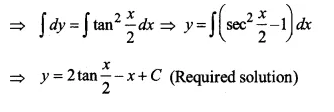
Ex 9.4 Class 12 Maths Question 2.
\(\frac { dy }{ dx } =\sqrt { 4-{ y }^{ 2 } } (-2<y<2)\)
Solution.
\(\frac { dy }{ dx } =\sqrt { 4-{ y }^{ 2 } } \Rightarrow \int { \frac { dy }{ \sqrt { { 4-y }^{ 2 } } } } =\int { dx } \)
\(\Rightarrow { sin }^{ -1 }\frac { y }{ 2 } =x+C \)
\(\Rightarrow y=2sin(x+C) \)
Ex 9.4 Class 12 Maths Question 3.
\(\frac { dy }{ dx } +y=1(y\neq 1)\)
Solution.
\(\frac { dy }{ dx } +y=1\Rightarrow \int { \frac { dy }{ y-1 } } =-\int { dx } \)
\(\Rightarrow log(y-1)=-x+c\Rightarrow y=1+{ e }^{ -x }.{ e }^{ c } \)
\(Hence\quad y=1+{ Ae }^{ -x }\)
which is required solution
Ex 9.4 Class 12 Maths Question 4.
sec² x tany dx+sec² y tanx dy = 0
Solution.
we have
sec² x tany dx+sec² y tanx dy = 0

Ex 9.4 Class 12 Maths Question 5.
\(\left( { e }^{ x }+{ e }^{ -x } \right) dy-\left( { e }^{ x }-{ e }^{ -x } \right) dx=0\)
Solution.
we have
\(\left( { e }^{ x }+{ e }^{ -x } \right) dy-\left( { e }^{ x }-{ e }^{ -x } \right) dx=0\)
Integrating on both sides

Ex 9.4 Class 12 Maths Question 6.
\(\frac { dy }{ dx } =\left( { 1+x }^{ 2 } \right) \left( { 1+y }^{ 2 } \right) \)
Solution.
\(\frac { dy }{ { 1+y }^{ 2 } } =\left( { 1+x }^{ 2 } \right) dx \)
integrating on both side we get
\({ tan }^{ -1 }y={ x+\frac { 1 }{ 3 } }x^{ 3 }+c \)
which is required solution
Ex 9.4 Class 12 Maths Question 7.
y logy dx – x dy = 0
Solution.
\(\because \quad y\quad logy\quad dx=x\quad dy\Rightarrow \frac { dy }{ y\quad logy } =\frac { dx }{ x } \)
integrating we get
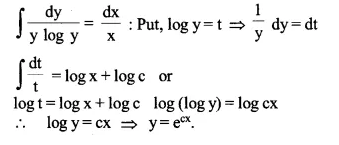
Ex 9.4 Class 12 Maths Question 8.
\({ x }^{ 5 }\frac { dy }{ dx } =-{ y }^{ 5 }\)
Solution.
\({ x }^{ 5 }\frac { dy }{ dx } =-{ y }^{ 5 }\Rightarrow \int { { y }^{ -5 }dy } =-\int { { x }^{ -5 }dx } \)
\(\Rightarrow -\frac { 1 }{ { y }^{ 4 } } =\frac { 1 }{ { x }^{ 4 } } +4c\Rightarrow { x }^{ -4 }+{ y }^{ -4 }=k\)
Ex 9.4 Class 12 Maths Question 9.
solve the following
\(\frac { dy }{ dx } ={ sin }^{ -1 }x\)
Solution.
\(\frac { dy }{ dx } ={ sin }^{ -1 }x\Rightarrow \int { dy } =\int { { sin }^{ -1 }xdx } \)
integrating both sides we get
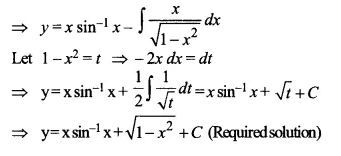
Ex 9.4 Class 12 Maths Question 10.
\({ e }^{ x }tany\quad dx+{ (1-e }^{ x }){ sec }^{ 2 }dy=0\)
Solution.
\({ e }^{ x }tany\quad dx+{ (1-e }^{ x }){ sec }^{ 2 }dy=0\)
we can write in another form

Find a particular solution satisfying the given condition for the following differential equation in Q.11 to 14.
Ex 9.4 Class 12 Maths Question 11.
\(\left( { x }^{ 3 }+{ x }^{ 2 }+x+1 \right) \frac { dy }{ dx } ={ 2x }^{ 2 }+x;y=1,when\quad x=0\)
Solution.
here
\(dy=\frac { { 2x }^{ 2 }+x }{ \left( { x }^{ 3 }+{ x }^{ 2 }+x+1 \right) } dx\)
integrating we get
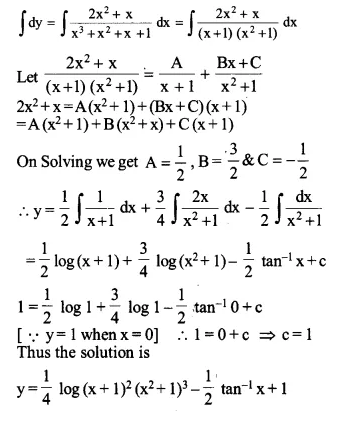
Ex 9.4 Class 12 Maths Question 12.
\(x\left( { x }^{ 2 }-1 \right) \frac { dy }{ dx } =1,y=0\quad when\quad x=2\)
Solution.
\(x\left( { x }^{ 2 }-1 \right) \frac { dy }{ dx } =1,y=0\quad when\quad x=2\)
\(\Rightarrow \int { dy } =\int { \frac { dy }{ x(x+1)(x-1) } } \)
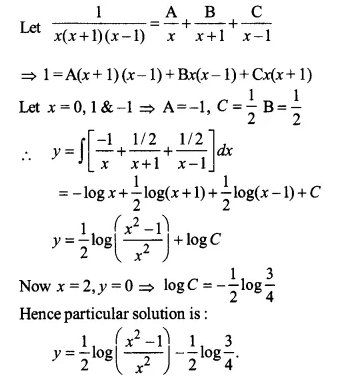
Ex 9.4 Class 12 Maths Question 13.
\(cos\left( \frac { dy }{ dx } \right) =a,(a\epsilon R),y=1\quad when\quad x=0\)
Solution.
\(cos\left( \frac { dy }{ dx } \right) =a\quad \therefore \frac { dy }{ dx } ={ cos }^{ -1 }a\)
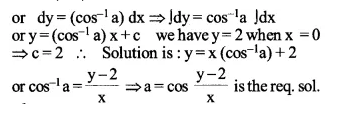
Ex 9.4 Class 12 Maths Question 14.
\(\frac { dy }{ dx } =ytanx,y=1\quad when\quad x=0\)
Solution.
\(\frac { dy }{ dx } =ytanx\Rightarrow \int { \frac { dy }{ y } } =\int { tanx\quad dx } \)
=> logy = logsecx + C
When x = 0, y = 1
=> log1 = log sec0 + C => 0 = log1 + C
=> C = 0
∴ logy = log sec x
=> y = sec x.
Ex 9.4 Class 12 Maths Question 15.
Find the equation of the curve passing through the point (0,0) and whose differential equation \({ y }^{ I }={ e }^{ x }sinx\)
Solution.
\({ y }^{ I }={ e }^{ x }sinx\)
\(\Rightarrow dy={ e }^{ x }sinx\quad dx\)

Ex 9.4 Class 12 Maths Question 16.
For the differential equation \(xy\frac { dy }{ dx } =(x+2)(y+2)\) find the solution curve passing through the point (1,-1)
Solution.
The differential equation is\(xy\frac { dy }{ dx } =(x+2)(y+2)\)
or xydy=(x + 2)(y+2)dx
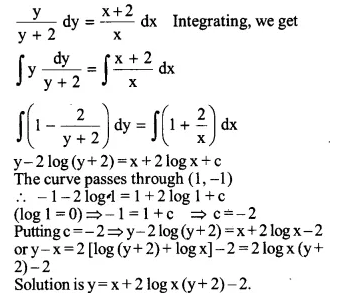
Ex 9.4 Class 12 Maths Question 17.
Find the equation of a curve passing through the point (0, -2) given that at any point (pc, y) on the curve the product of the slope of its tangent and y-coordinate of the point is equal to the x-coordinate of the point
Solution.
According to the question \(y\frac { dy }{ dx } =x\)
\(\Rightarrow \int { ydy } =\int { xdx } \Rightarrow \frac { { y }^{ 2 } }{ 2 } =\frac { { x }^{ 2 } }{ 2 } +c\)
0, – 2) lies on it.c = 2
∴ Equation of the curve is : x² – y² + 4 = 0.
Ex 9.4 Class 12 Maths Question 18.
At any point (x, y) of a curve the slope of the tangent is twice the slope of the line segment joining the point of contact to the point (-4,-3) find the equation of the curve given that it passes through (- 2,1).
Solution.
Slope of the tangent to the curve = \(\frac { dy }{ dx }\)
slope of the line joining (x, y) and (- 4, – 3)
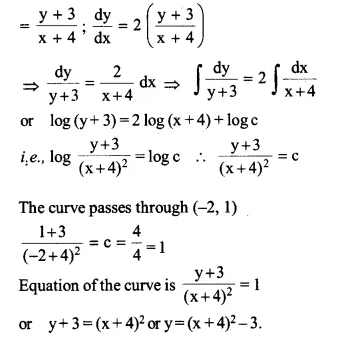
Ex 9.4 Class 12 Maths Question 19.
The volume of a spherical balloon being inflated changes at a constant rate. If initially its radius is 3 units and offer 3 seconds it is 6 units. Find the radius of balloon after t seconds.
Solution.
Let v be volume of the balloon.

Ex 9.4 Class 12 Maths Question 20.
In a bank principal increases at the rate of r% per year. Find the value of r if Rs 100 double itself in 10 years
Solution.
Let P be the principal at any time t.
According to the problem
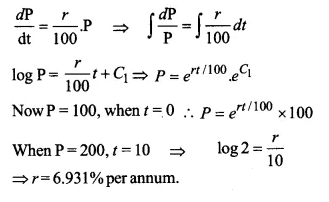
Ex 9.4 Class 12 Maths Question 21.
In a bank principal increases at the rate of 5% per year. An amount of Rs 1000 is deposited with this bank, how much will it worth after 10 years
Solution.
Let p be the principal Rate of interest is 5%
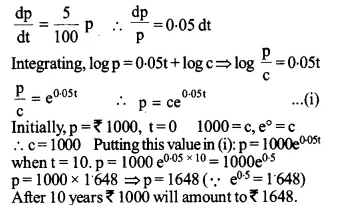
Ex 9.4 Class 12 Maths Question 22.
In a culture the bacteria count is 1,00,000. The number is increased by 10% in 2 hours. In how many hours will the count reach 2,00,000 if the rate of growth of bacteria is proportional to the number present
Solution.
Let y denote the number of bacteria at any instant t • then according to the question
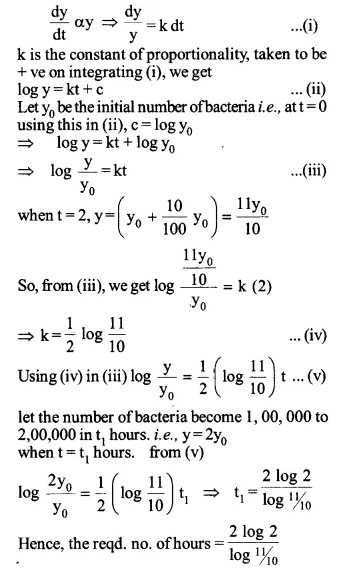
Ex 9.4 Class 12 Maths Question 23.
The general solution of a differential equation \(\frac { dy }{ dx } ={ e }^{ x+y } \) is
(a) \({ e }^{ x }+{ e }^{ -y }=c \)
(b) \({ e }^{ x }+{ e }^{ y }=c \)
(c) \({ e }^{ -x }+{ e }^{ y }=c \)
(d) \({ e }^{ -x }+{ e }^{ -y }=c \)
Solution.
(a) \(\frac { dy }{ dx } ={ e }^{ x }.{ e }^{ y }\Rightarrow \int { { e }^{ -y }dy } =\int { { e }^{ x }dx } \)
\(\Rightarrow { e }^{ -y }={ e }^{ x }+k\Rightarrow { e }^{ x }+{ e }^{ -y }=c \)
NCERT Solutions for Class 12 Maths Chapter 9 Differential Equations Ex 9.5
Show that the given differential equation is homogeneous and solve each of them in Questions 1 to 10
<Ex 9.5 Class 12 Maths Question 1.
(x²+xy)dy = (x²+y²)dx
Solution.
(x²+xy)dy = (x²+y²)dx
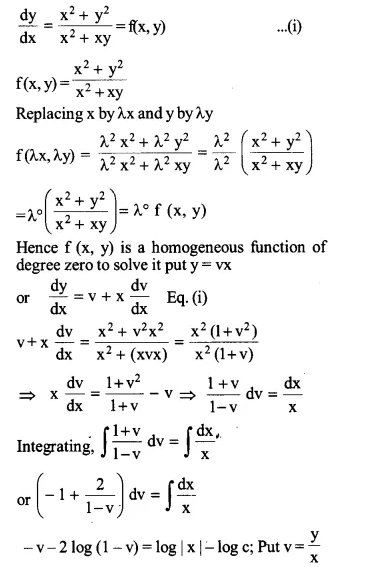
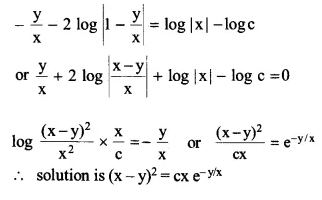
Ex 9.5 Class 12 Maths Question 2.
\({ y }^{ I }=\frac { x+y }{ x } \)
Solution.
\({ y }^{ I }=\frac { x+y }{ x } \)

Ex 9.5 Class 12 Maths Question 3.
(x-y)dy-(x+y)dx=0
Solution.
\(\frac { dy }{ dx } =\frac { x+y }{ x-y } =\frac { 1+\frac { y }{ x } }{ 1-\frac { y }{ x } } \)
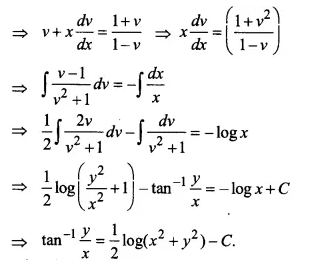
Ex 9.5 Class 12 Maths Question 4.
(x²-y²)dx+2xy dy=0
Solution.
\(\frac { dy }{ dx } =\frac { { y }^{ 2 }-{ x }^{ 2 } }{ 2xy } \)

Ex 9.5 Class 12 Maths Question 5.
\({ x }^{ 2 }\frac { dy }{ dx } ={ x }^{ 2 }-{ 2y }^{ 2 }+xy\)
Solution.
\(\frac { dy }{ dx } =1-2{ \left( \frac { y }{ x } \right) }^{ 2 }+\frac { y }{ x } \)
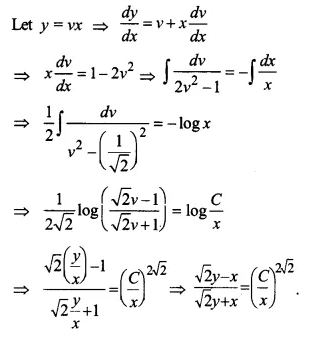
Ex 9.5 Class 12 Maths Question 6.
\(xdy-ydx=\sqrt { { x }^{ 2 }+{ y }^{ 2 } } dx\)
Solution.
\(xdy-ydx=\sqrt { { x }^{ 2 }+{ y }^{ 2 } } dx\)

Ex 9.5 Class 12 Maths Question 7.
\(\left\{ xcos\left( \frac { y }{ x } \right) +ysin\left( \frac { y }{ x } \right) \right\} ydx=\left\{ ysin\left( \frac { y }{ x } \right) -xcos\left( \frac { y }{ x } \right) \right\} xdy\)
Solution.
\(\left\{ xcos\left( \frac { y }{ x } \right) +ysin\left( \frac { y }{ x } \right) \right\} ydx=\left\{ ysin\left( \frac { y }{ x } \right) -xcos\left( \frac { y }{ x } \right) \right\} xdy\)
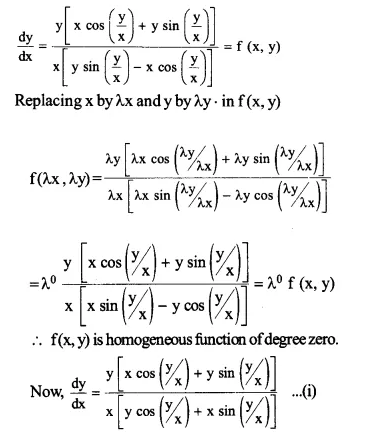
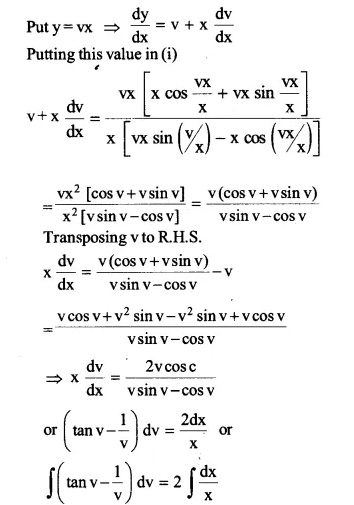
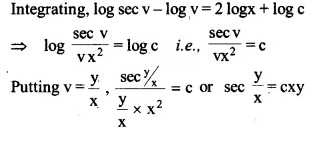
Ex 9.5 Class 12 Maths Question 8.
\(x\frac { dy }{ dx } -y+xsin\left( \frac { y }{ x } \right) =0\)
Solution.
\(x\frac { dy }{ dx } -y+xsin\left( \frac { y }{ x } \right) =0\Rightarrow \frac { dy }{ dx } =\frac { y }{ x } -sin\frac { y }{ x } \)
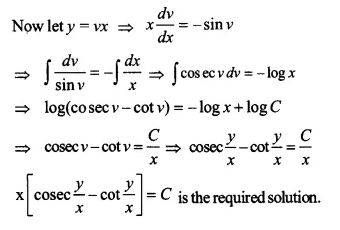
Ex 9.5 Class 12 Maths Question 9.
\(ydx+xlog\left( \frac { y }{ x } \right) dy-2xdy=0\)
Solution.
\(\frac { dy }{ dx } =\frac { y }{ 2x-xlog\frac { y }{ x } } =\frac { \frac { y }{ x } }{ 2-log\frac { y }{ x } } \)
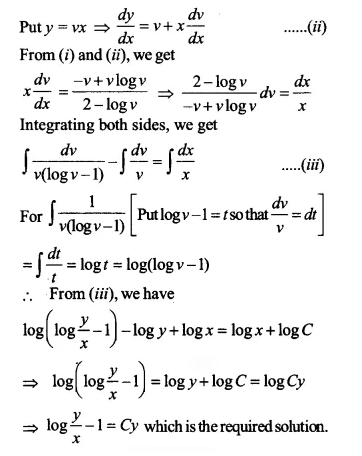
Ex 9.5 Class 12 Maths Question 10.
\(\left( { 1+e }^{ \frac { x }{ y } } \right) dx+{ e }^{ \frac { x }{ y } }\left( 1-\frac { x }{ y } \right) dy=0\)
Solution.
\(\frac { dx }{ dy } =-\frac { { e }^{ \frac { x }{ y } }\left( 1-\frac { x }{ y } \right) }{ { 1+e }^{ \frac { x }{ y } } } =\frac { \left( \frac { x }{ y } -1 \right) { e }^{ \frac { x }{ y } } }{ { 1+e }^{ \frac { x }{ y } } } =f(x,y)\)
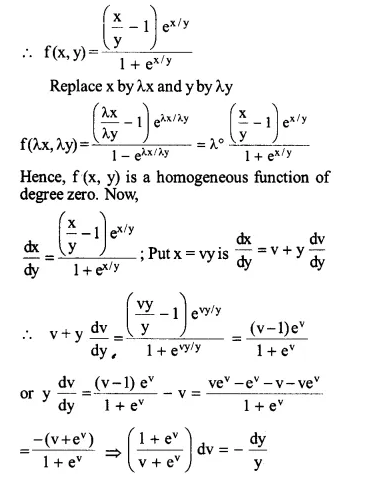
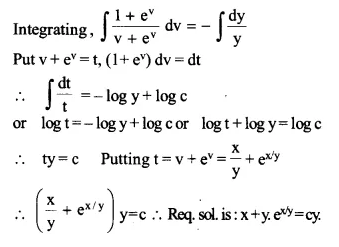
For each of the following differential equation in Q 11 to 15 find the particular solution satisfying the given condition:
Ex 9.5 Class 12 Maths Question 11.
(x + y) dy+(x – y)dx = 0,y = 1 when x = 1
Solution.
given
(x + y) dy+(x – y)dx = 0

Ex 9.5 Class 12 Maths Question 12.
x²dy+(xy+y²)dx=0, y=1 when x=1
Solution.
\(\frac { dy }{ dx } =\frac { xy+{ y }^{ 2 } }{ { x }^{ 2 } } =f(x,y)\)
f(x,y) is homogeneous
∴ put y = vx
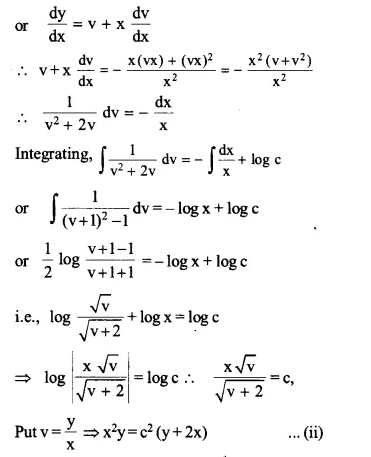
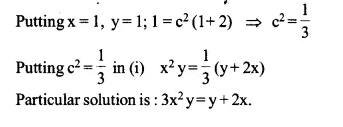
Ex 9.5 Class 12 Maths Question 13.
\(\left( x{ sin }^{ 2 }\frac { y }{ x } -y \right) dx+xdy=0,y=\frac { \pi }{ 4 } ,when\quad x=1\)
Solution.
\(\left( x{ sin }^{ 2 }\frac { y }{ x } -y \right) dx+xdy=0\)
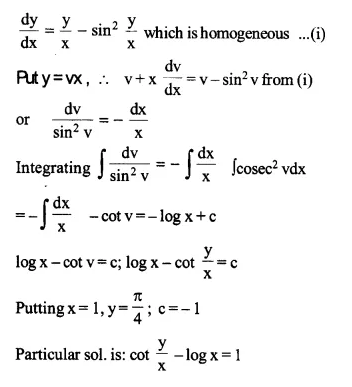
Ex 9.5 Class 12 Maths Question 14.
\(\frac { dy }{ dx } -\frac { y }{ x } +cosec\left( \frac { y }{ x } \right) =0,y=0\quad when\quad x=1\)
Solution.
\(\frac { dy }{ dx } -\frac { y }{ x } +cosec\left( \frac { y }{ x } \right) =0\)
which is a homogeneous differential equation
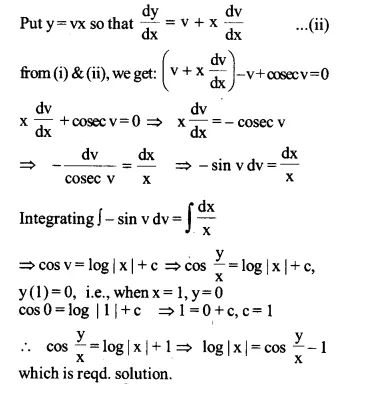
Ex 9.5 Class 12 Maths Question 15.
\(2xy-{ y }^{ 2 }-{ 2x }^{ 2 }\frac { dy }{ dx } =0,y=2,when\quad x=1\)
Solution.
\(\frac { dy }{ dx } =\frac { y }{ x } +\frac { 1 }{ 2 } { \left( \frac { y }{ x } \right) }^{ 2 }\) …(i)
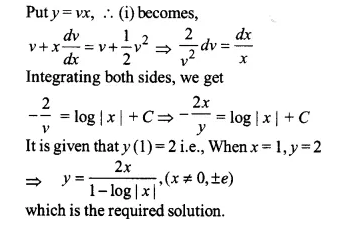
Ex 9.5 Class 12 Maths Question 16.
A homogeneous equation of the form \(\frac { dx }{ dy } =h\left( \frac { x }{ y } \right) \) can be solved by making the substitution,
(a) y=vx
(b) v=yx
(c) x=vy
(d) x=v
Solution.
(c) option x = vy
Ex 9.5 Class 12 Maths Question 17.
Which of the following is a homogeneous differential equation?
(a) (a) (4x + 6y + 5)dy-(3y + 2x + 4)dx = 0
(b) \((xy)dx-({ x }^{ 3 }+{ y }^{ 3 })dy\)
(c) \(({ x }^{ 3 }+{ 2y }^{ 2 })dx+2xydy=0\)
(d) \({ y }^{ 2 }dx+{ (x }^{ 2 }-xy-{ y }^{ 2 })dy=0\)
Solution.
(d)
NCERT Solutions for Class 12 Maths Chapter 9 Differential Equations Ex 9.6
Find the general solution of the following differential equations in Q.1 to 12
<Ex 9.6 Class 12 Maths Question 1.
\(\frac { dy }{ dx } +2y=sinx\)
Solution.
Given equation is a linear differential equation of the form \(\frac { dy }{ dx } +Py=Q\);
Here, P = 2, Q = sin x

Ex 9.6 Class 12 Maths Question 2.
\(\frac { dy }{ dx } +3y={ e }^{ -2x }\)
Solution.
\(\frac { dy }{ dx } +3y={ e }^{ -2x }\)
Here P = 3, \(IF={ e }^{ \int { p.dx } }={ e }^{ 3x }\)

which is required equation
Ex 9.6 Class 12 Maths Question 3.
\(\frac { dy }{ dx } +\frac { y }{ x } ={ x }^{ 2 }\)
Solution.
\(\frac { dy }{ dx } +\frac { y }{ x } ={ x }^{ 2 }\)
\(IF={ e }^{ \int { \frac { 1 }{ x } dx } }={ e }^{ logx }=x\)
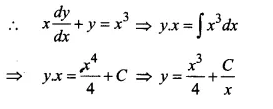
Ex 9.6 Class 12 Maths Question 4.
\(\frac { dy }{ dx } +(secx)y=tanx\left( 0\le x<\frac { \pi }{ 2 } \right) \)
Solution.
Here, P = secx, Q = tanx; \(IF={ e }^{ \int { p.dx } }={ e }^{ \int { secx.dx } }\)
\(={ e }^{ log|secx+tanx| }\)
= sec x + tan x
i.e., The solu. is y.× I.F. = ∫Q × I.F. dx + c
or y × (secx+tanx) = ∫tanx(secx+tanx)dx+c
Reqd. sol. is
∴ y(secx + tanx) = (secx + tanx)-x + c
Ex 9.6 Class 12 Maths Question 5.
\({ cos }^{ 2 }x\frac { dy }{ dx } +y=tanx\left( 0\le x\le \frac { \pi }{ 2 } \right) \)
Solution.
\(\frac { dy }{ dx } +{ y\quad sec }^{ 2 }x={ sec }^{ 2 }x\quad tanx\)
⇒ integrating factor = \({ e }^{ \int { { sec }^{ 2 }xdx } }={ e }^{ tanx }\)

Ex 9.6 Class 12 Maths Question 6.
\(x\frac { dy }{ dx } +2y={ x }^{ 2 }logx\)
Solution.
\(\frac { dy }{ dx } +\frac { 2 }{ x } y\quad =\quad x\quad logx\)
Here P = \(\frac { 2 }{ x }\) and Q = x logx

Ex 9.6 Class 12 Maths Question 7.
\(xlogx\frac { dy }{ dx } +y=\frac { 2 }{ x } logx\)
Solution.
\(\frac { dy }{ dx } +\frac { 1 }{ xlogx } y=\frac { 2 }{ { x }^{ 2 } } \)
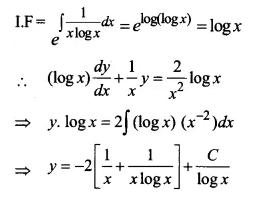
Ex 9.6 Class 12 Maths Question 8.
(1+x²)dy+2xy dx = cotx dx(x≠0)
Solution.
(1+x²)dy+2xy dx = cotx dx

Ex 9.6 Class 12 Maths Question 9.
\(x\frac { dy }{ dx } +y-x+xy\quad cotx=0(x\neq 0)\)
Solution.
\(x\frac { dy }{ dx } +y-x+xy\quad cotx=0\)
\(x\frac { dy }{ dx } +(1+xcot x)y=x\)
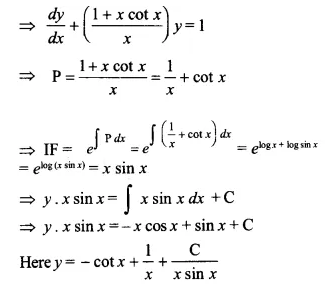
Ex 9.6 Class 12 Maths Question 10.
\((x+y)\frac { dy }{ dx } =1\)
Solution.
\((x+y)\frac { dy }{ dx } =1\)
\(\frac { 1 }{ (x+y) } \frac { dx }{ dy } =1\Rightarrow \frac { dx }{ dy } =x+y\)
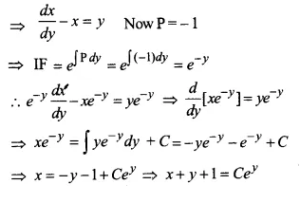
Ex 9.6 Class 12 Maths Question 11.
\(ydx+(x-{ y }^{ 2 })dy=0\)
Solution.
\(ydx+(x-{ y }^{ 2 })dy=0\)
\(\Rightarrow y\frac { dx }{ dy } +x-{ y }^{ 2 }=0\)
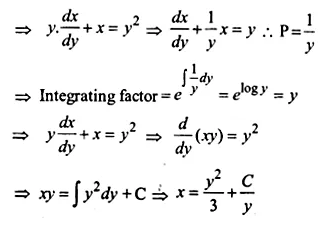
Ex 9.6 Class 12 Maths Question 12.
\(\left( { x+3y }^{ 2 } \right) \frac { dy }{ dx } =y(y>0)\)
Solution.
\(y\frac { dx }{ dy } =x+{ 3y }^{ 2 }\quad or\quad \frac { dx }{ dy } -\frac { x }{ y } =3y\)
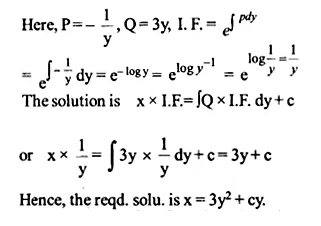
For each of the following Questions 13 to is find a particular solution, satisfying the given condition:
Ex 9.6 Class 12 Maths Question 13.
\(\frac { dy }{ dx } +2ytanx=sinx,y=0\quad when\quad x=\frac { \pi }{ 3 } \)
Solution.
\(\frac { dy }{ dx } +(2tanx)y=sinx,P=2tanx\)
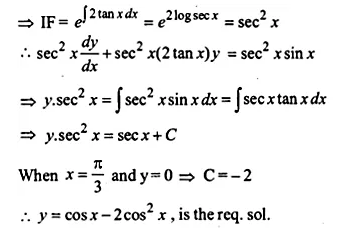
Ex 9.6 Class 12 Maths Question 14.
\(\left( 1+{ x }^{ 2 } \right) \frac { dy }{ dx } +2xy=\frac { 1 }{ 1+{ x }^{ 2 } } ,y=0\quad when\quad x=1\)
Solution.
\(\frac { dy }{ dx } +\frac { 2x }{ 1+{ x }^{ 2 } } y=\frac { 1 }{ { \left( { 1+x }^{ 2 } \right) }^{ 2 } } \)

Ex 9.6 Class 12 Maths Question 15.
\(\frac { dy }{ dx } -3ycotx=sin2x,y=2\quad when\quad x=\frac { \pi }{ 2 } \)
Solution.
Here P = -3cot x
Q = sin 2x
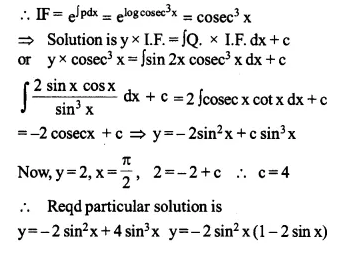
Ex 9.6 Class 12 Maths Question 16.
Find the equation of the curve passing through the origin given that the slope of the tangent to the curve at any point (x,y) is equal to the sum of the coordinates of the point
Solution.
\(\frac { dy }{ dx } =x+y\Rightarrow \frac { dy }{ dx } -y=x\Rightarrow P=-1\)
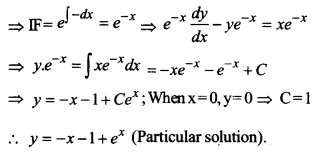
Ex 9.6 Class 12 Maths Question 17.
Find the equation of the curve passing through the point (0, 2) given that the sum of the coordinates of any point on the curve exceeds the magnitude of the slope of the tangent to the curve at that point by 5
Solution.
By the given condition
\(x+y-\left| \frac { dy }{ dx } \right|=5\)
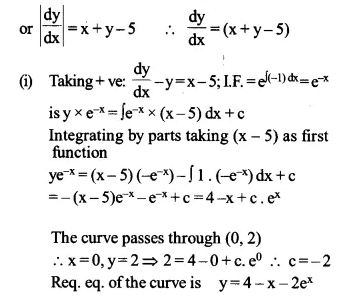

Ex 9.6 Class 12 Maths Question 18.
The integrating factor of the differential equation \(x\frac { dy }{ dx } -y={ 2x }^{ 2 }\)
(a) \({ e }^{ -x }\)
(b) \({ e }^{ -y }\)
(c) \(\frac { 1 }{ x } \)
(d) x
Solution.
(c) \(P=\frac { -1 }{ x } \therefore IF={ e }^{ -\int { \frac { 1 }{ x } dx } }={ e }^{ -logx }=\frac { 1 }{ x } \)
Ex 9.6 Class 12 Maths Question 19.
The integrating factor of the differential equation \(\left( { 1-y }^{ 2 } \right) \frac { dx }{ dy } +yx=ay\)(-1<y<1) is
(a) \(\frac { 1 }{ { y }^{ 2 }-1 } \)
(b) \(\frac { 1 }{ \sqrt { { y }^{ 2 }-1 } } \)
(c) \(\frac { 1 }{ 1-{ y }^{ 2 } } \)
(d) \(\frac { 1 }{ \sqrt { { 1-y }^{ 2 } } } \)
Solution.
(d) \(\left( { 1-y }^{ 2 } \right) \frac { dx }{ dy } +yx=ay\)
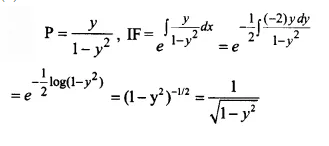
NCERT Class 12 Maths
Class 12 Maths Chapters | Maths Class 12 Chapter 9
Chapterwise NCERT Solutions for Class 12 Maths
-
NCERT Solutions For Class 12 Maths Chapter 1 Relations and Functions
NCERT Solutions For Class 12 Maths Chapter 2 Inverse Trigonometric Functions
NCERT Solutions For Class 12 Maths Chapter 3 Matrix
NCERT Solutions For Class 12 Maths Chapter 4 Determinants
NCERT Solutions For Class 12 Maths Chapter 5 Continuity and Differentiability
NCERT Solutions For Class 12 Maths Chapter 6 Application of Derivatives
NCERT Solutions For Class 12 Maths Chapter 7 Integrals
NCERT Solutions For Class 12 Maths Chapter 8 Application of Integrals
NCERT Solutions For Class 12 Maths Chapter 9 Differential Equations
NCERT Solutions For Class 12 Maths Chapter 10 Vector Algebra
NCERT Solutions For Class 12 Maths Chapter 11 Three-dimensional Geometry
NCERT Solutions For Class 12 Maths Chapter 12 Linear Programming
NCERT Solutions For Class 12 Maths Chapter 13 Probability
| NCERT Solutions for Class 12 All Subjects | NCERT Solutions for Class 10 All Subjects |
| NCERT Solutions for Class 11 All Subjects | NCERT Solutions for Class 9 All Subjects |

Post a Comment
इस पेज / वेबसाइट की त्रुटियों / गलतियों को यहाँ दर्ज कीजिये
(Errors/mistakes on this page/website enter here)